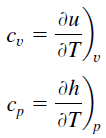About Potassium
Potassium was first isolated from potash, the ashes of plants, from which its name derives. In the periodic table, potassium is one of the alkali metals. All of the alkali metals have a single valence electron in the outer electron shell, which is easily removed to create an ion with a positive charge – a cation, which combines with anions to form salts. Naturally occurring potassium is composed of three isotopes, of which 40K is radioactive. Traces of 40K are found in all potassium, and it is the most common radioisotope in the human body.
Potassium – Specific Heat, Latent Heat of Fusion, Latent Heat of Vaporization
Specific heat of Potassium is 0.75 J/g K.
Heat capacity is an extensive property of matter, meaning it is proportional to the size of the system. Heat capacity C has the unit of energy per degree or energy per kelvin. When expressing the same phenomenon as an intensive property, the heat capacity is divided by the amount of substance, mass, or volume, thus the quantity is independent of the size or extent of the sample.
Latent Heat of Fusion of Potassium is 2.334 kJ/mol.
Latent Heat of Vaporization of Potassium is 79.87 kJ/mol.
Latent heat is the amount of heat added to or removed from a substance to produce a change in phase. This energy breaks down the intermolecular attractive forces, and also must provide the energy necessary to expand the gas (the pΔV work). When latent heat is added, no temperature change occurs. The enthalpy of vaporization is a function of the pressure at which that transformation takes place.
See also: Mechanical Properties of Potassium
Summary
| Element | Potassium |
| Specific Heat | 0.75 J/g K |
| Heat of Fusion | 2.334 kJ/mol |
| Heat of Vaporization | 79.87 kJ/mol |
| Density | 0.856 g/cm3 |
Source: www.luciteria.com


















